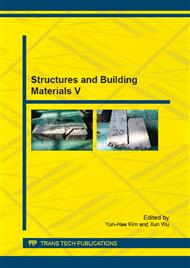p.190
p.194
p.201
p.215
p.220
p.224
p.229
p.233
p.237
Effect of Corrosion Pit Position on Mechanical Properties of Corroded HRB400 Reinforced Bar
Abstract:
Corrosion of steel bars has become the primary cause for the concrete durability problem. Stress concentration due to uneven corrosion affect the mechanical properties of reinforced bar. This paper take HRB400 rebar for example to analyze the effect. FEM is conducted to analyze the effect of corrosion pit position on yield strength and ultimate strength. The result shows that corrosion pit in transverse rib has a different effect on yield strength and ultimate strength, while corrosion pit in longitudinal rib and reinforced column make yield strength and ultimate strength of reinforced bar decrease in varying degrees.
Info:
Periodical:
Pages:
220-223
Citation:
Online since:
July 2015
Authors:
Keywords:
Price:
Сopyright:
© 2015 Trans Tech Publications Ltd. All Rights Reserved
Share:
Citation:


